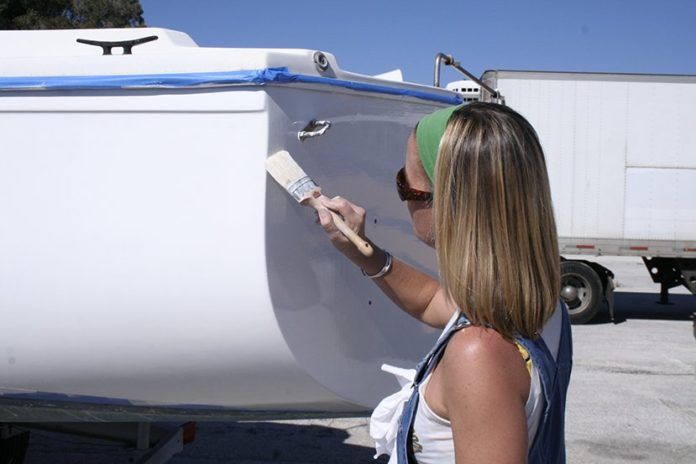The results derived from a professionally applied LPU topside refinish are as dramatic as the invoice that accompanies the makeover. The shiny, wet look and the protection it affords can last for years-whether its three years, five years, or nearly a decade depends upon how kindly the rejuvenated surface is treated. Two-part polyester urethane coatings such as Awlgrip II are tough, gloss-retaining coatings that will put up with some abrasion, but if you make it a regular occurrence, both the gloss and the paint will eventually go away.
Giving your topsides proper maintenance attention, like waxing regularly, will keep them looking healthy.
- During application: Most well-executed LPU paint jobs begin with epoxy primers and fairing compounds as the underpinnings of a glistening LPU topcoat. When it comes to longevity, applying enough mil thickness of paint is paramount, and each paint manufacturer specs out a wet thickness or volume of paint per given amount of surface area by which the applicator can determine when enough material has been applied.
- Cleaning: Regularly sponge washing the hull is the first step in preserving the topcoats shine. Avoid cleaning with scrub pads and gritty cleaners; this should be a completely non-abrasive effort. Many paint makers offer their own mild detergent, and weve found Awlwash by Awlgrip to be a very effective, completely non-abrasive cleaner. The purpose of these regular washdowns is to remove dirt and chemical residue transferred to the topsides by atmospheric deposition. Over time, such contaminants will diminish gloss and trap grit, increasing the abrasive effect that fenders have when they rub against the topsides.
- Sailing is not a full-contact sport: More often than not, the decision to have the topsides re-painted has to do with localized damage that resulted from docking maneuvers gone awry, tussles at the starting line, or storm damage when a line gives way. Those who can avoid such bumps and bruises can nurse the gloss for many more years. Eventually the surface will need to be repainted, but if there is a minimum of dings, scrapes, and damage, and the primer is intact, the paint prep process will be much less invasive and the cost of extensive fairing will be less.
- Wax On-Wax Off: After the first two or three seasons of washing and protecting the surface from winter-cover abrasion and line chafe, there’s often a need to tune up the gloss a bit. The best bet is to follow up another good washing with a conventional carnauba-based wax like Mothers California Gold or Collinites #885 (PSs Best Choice for paste waxes, July 2009). The reason for using this wax rather than a deeper-penetrating copolymer polish is that at some point, repainting the surface will be in the cards and polishes that reside deep in the porosity of an aging finish are hard to remove and can cause possible surface contamination. The same goes for silicone-based shine restorers that can make a surface gleam, but leave behind a coating that can cause fish eye craters and poor adhesion in the next coat of paint.
- Breathe life into dull coats: Owners of boats with five- to seven-year-old intact LPU paint jobs that look dull but remain well adhered, can try rubbing out the surface with 3M Perfect-It rubbing compound and following up with a carnauba wax. In such cases, the gloss often can be readily restored, but as with older gelcoat, the new shine is derived from the smoothness of the surface and the wax, not the paint coating alone.
- Repair care: Repairs to two-part LPU coatings are a true test of product awareness and applicator talent. The challenge lies in blending the old and the new, and blending the circumference known as the overspray region. Matching color change and gloss variation is even tougher than automotive work. The reason for these difficulties is the quality of the paint itself. Polyester LPU coatings are so tough that attempting to rub out the overspray line associated with a repair can result in too much heat and the dulling of gloss around the perimeter of the new paint. Picking the right time to buff back this boundary between new and old paint, and using the right rubbing/polishing products is a well-kept trade secret among craftsmen. Most love the 3M products Perfect-it, and Finesse-it.
One of the reasons why AwlCraft and other slightly softer and more user-friendly acrylic-based LPU paints are growing in popularity is that they are much easier to repair and buff than polyester-based two-part paints. Their longevity is good, but not quite that of old standby Awlgrip.
If you are planning a new paint job and looking for a durable, long-lasting finish, the December 2012 issue of Practical Sailor compared linear polyurethane paints after three years.





































